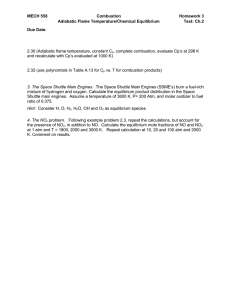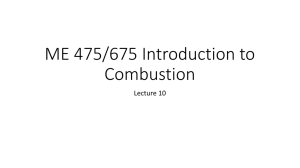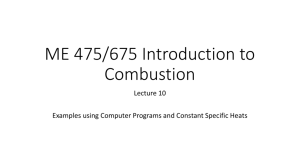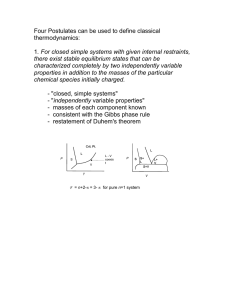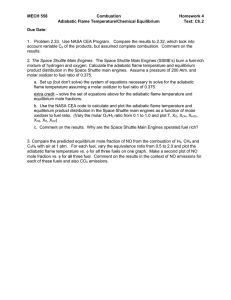MECH 558 Combustion Class Notes - Page: notes03.doc
advertisement
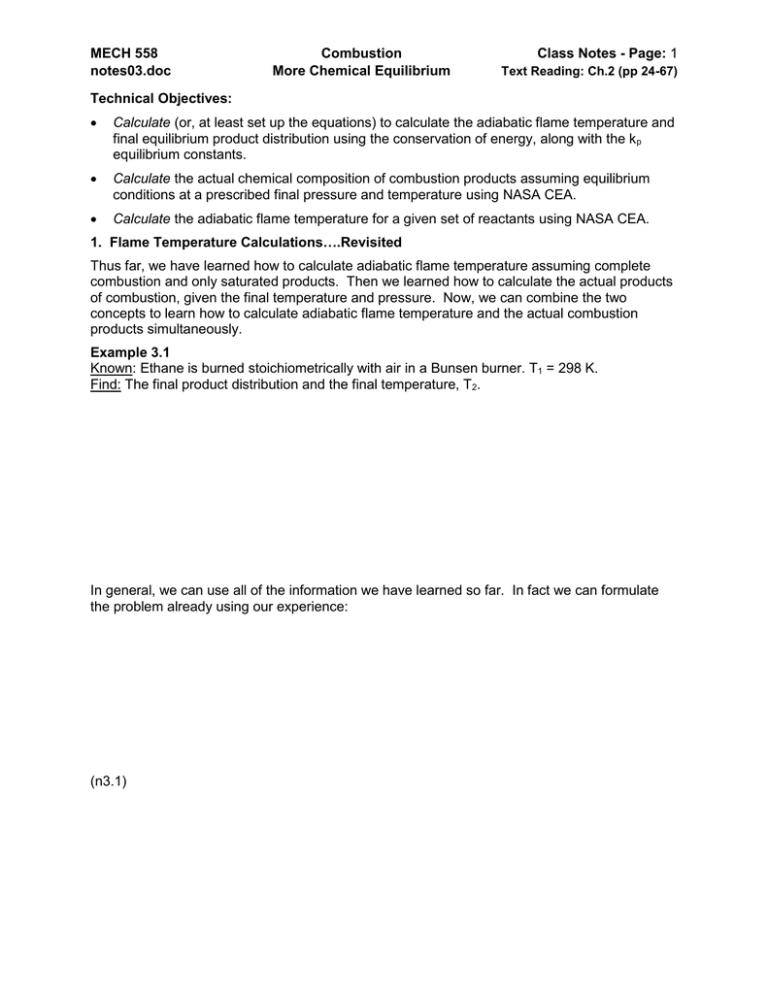
MECH 558 notes03.doc Combustion More Chemical Equilibrium Class Notes - Page: 1 Text Reading: Ch.2 (pp 24-67) Technical Objectives: Calculate (or, at least set up the equations) to calculate the adiabatic flame temperature and final equilibrium product distribution using the conservation of energy, along with the k p equilibrium constants. Calculate the actual chemical composition of combustion products assuming equilibrium conditions at a prescribed final pressure and temperature using NASA CEA. Calculate the adiabatic flame temperature for a given set of reactants using NASA CEA. 1. Flame Temperature Calculations….Revisited Thus far, we have learned how to calculate adiabatic flame temperature assuming complete combustion and only saturated products. Then we learned how to calculate the actual products of combustion, given the final temperature and pressure. Now, we can combine the two concepts to learn how to calculate adiabatic flame temperature and the actual combustion products simultaneously. Example 3.1 Known: Ethane is burned stoichiometrically with air in a Bunsen burner. T1 = 298 K. Find: The final product distribution and the final temperature, T2. In general, we can use all of the information we have learned so far. In fact we can formulate the problem already using our experience: (n3.1) MECH 558 notes03.doc Combustion More Chemical Equilibrium Class Notes - Page: 2 Text Reading: Ch.2 (pp 24-67) But now, unlike in the TP case, the final temperature T2 is unknown! Since we have one more unknown, we need one more equation. What equation can we use? Constructing a control volume around the Bunsen burner: We can formulate the First Law of Thermodynamics on a molar basis for this control volume: (n3.2) Substituting the total enthalpy into the above equation yields: (n3.3) Since, in our example, the inlet temperature was 298 K, the enthalpy difference terms are all zero. Furthermore, the Heat of Formation terms for Nitrogen, and Oxygen are also zero. Canceling out these terms yields the following equation: (n3.4) Recalling that the sensible enthalpy is related to the specific heat, we can substitute these relationships into the above equation: (n3.5) Finally, recall that we postulated the following products to be present at equilibrium: N2, CO2, H2O, OH, CO, O2 and H2 MECH 558 notes03.doc Combustion More Chemical Equilibrium Class Notes - Page: 3 Text Reading: Ch.2 (pp 24-67) Substituting, results in the final equation needed to solve the problem: (n3.6) The energy equation can be solved along with the conservation of element equations and Kp equations (n3.3) to determine the molar quantities of each component and the adiabatic flame temperature, T2. Some notes on the above equation: The right hand side contains all the energy input into the system. The left hand side is where all of the energy goes. Note how much of the energy goes into heating the nitrogen. For every 1 mole of oxygen burned, we have to heat up 3.76 moles of nitrogen. In general, the reactants will not be entering the flame at 298 K, so the left hand side of the equation might be more complicated. We ignored species such as NO. Solution Scheme: So, how do we solve this problem? Generally, we have to solve it iteratively, just like the TP problem. Here is one scheme: 1. Guess a T2. 2. Use the guessed T2 value to evaluate all of the Kp’s at T2. 3. Iterate through the element conservation and Kp equations until they converge to solve for all of the molar quantities, ni. 4. Plug the predicted molar quantities into the energy equation and see if the energy equation is satisfied. If not, go to step 1. MECH 558 notes03.doc Combustion More Chemical Equilibrium Class Notes - Page: 4 Text Reading: Ch.2 (pp 24-67) 2. Computer Models for Equilibrium Calculations As you know from HW #3, equilibrium calculations are difficult enough by hand, even if you know the final temperature, T2. Solving for the adiabatic flame temperature using equations (n3.1) and (n3.6), for example, is even more difficult. Fortunately, there are a variety of computer programs that you can use to solve these problems. Example programs are as follows: After you have done an equilibrium calculation or two, it is well within your rights to use a computer code to calculate the answers for you. It is still a good idea to set up the problem by hand, though, because the "Art of Equilibrium" still applies. In other words, if you do not set up the problem, you will have no idea if the answers that the code gives you are reasonable. When using scientific and engineering computer codes, remember the saying, "garbage in…garbage out!" The NASA CEA Computer Code The NASA CEA Computer Code is available for download from the course web site: http://www.engr.colostate.edu/~marchese/combustion08/cec.htm It can be copied (along with several required data files) directly to your hard drive. It runs in a .dos shell. The executable is named cea300.exe Example 3.2. The NOx problem revisited. Air is heated to 2000K at 1 atm. How many ppm of NO and NO2 will be present at equilibrium? The following input data set was supplied to the CEA program: problem tp equilibrium p,psia=14.7 t(k)=2000.0 reactants fuel = N2 moles=0.79 oxid = O2 moles=0.21 output siunits end The NASA CEA code predicted the following equilibrium mole fractions: MECH 558 notes03.doc Combustion More Chemical Equilibrium Class Notes - Page: 5 Text Reading: Ch.2 (pp 24-67) ******************************************************************************* NASA-LEWIS CHEMICAL EQUILIBRIUM PROGRAM CEA, APR. 28, 1997 BY BONNIE MCBRIDE AND SANFORD GORDON REFS: NASA RP-1311, PART I, 1994 AND NASA RP-1311, PART II, 1996 ******************************************************************************* THERMODYNAMIC EQUILIBRIUM PROPERTIES AT ASSIGNED TEMPERATURE AND PRESSURE REACTANT FUEL OXIDANT O/F= MOLES N2 O2 .30364 .7900000 .2100000 %FUEL= 76.708300 R,EQ.RATIO= .000000 ENERGY KJ/KG-MOL .000 .000 PHI,EQ.RATIO= THERMODYNAMIC PROPERTIES P, BAR T, K RHO, KG/CU M H, KJ/KG U, KJ/KG G, KJ/KG S, KJ/(KG)(K) 1.0135 2000.00 1.7582-1 1994.80 1418.33 -16042.7 9.0187 M, (1/n) (dLV/dLP)t (dLV/dLT)p Cp, KJ/(KG)(K) GAMMAs SON VEL,M/SEC 28.846 -1.00008 1.0023 1.3457 1.2740 857.0 MOLE FRACTIONS *NO NO2 *N2 *O *O2 .00758 .00001 .78609 .00030 .20602 * THERMODYNAMIC PROPERTIES FITTED TO 20000.K PRODUCTS WHICH WERE CONSIDERED BUT WHOSE MOLE FRACTIONS WERE LESS THAN 5.000000E-06 FOR ALL ASSIGNED CONDITIONS *N N2O5 NO3 N3 N2O O3 TEMP K .000 .000 N2O3 Note: Our calculations were pretty good. We should have included O atom. N2O4 .000000 MECH 558 notes03.doc Combustion More Chemical Equilibrium Class Notes - Page: 6 Text Reading: Ch.2 (pp 24-67) Example 3.3. Adiabatic Flame Temperature Ethane and air are burned stoichiometrically in a bunsen burner at 1 Atm. Assuming no heat loss, what are the final temperature and mole fractions? The following input data set was supplied to the CEA program: problem hp equilibrium p,psia=14.7 reactants fuel = C2H6 moles=1 t(k)=298 oxid = O2 moles=3.5 t(k)=298 oxid = N2 moles=13.16 t(K)=298 output siunits end The code predicted the following: ******************************************************************************* NASA-LEWIS CHEMICAL EQUILIBRIUM PROGRAM CEA, APR. 28, 1997 BY BONNIE MCBRIDE AND SANFORD GORDON REFS: NASA RP-1311, PART I, 1994 AND NASA RP-1311, PART II, 1996 ******************************************************************************* THERMODYNAMIC EQUILIBRIUM COMBUSTION PROPERTIES AT ASSIGNED PRESSURES REACTANT FUEL OXIDANT OXIDANT O/F= C2H6 O2 N2 15.98467 1.0000000 3.5000000 13.1600000 %FUEL= THERMODYNAMIC PROPERTIES P, BAR T, K RHO, KG/CU M H, KJ/KG U, KJ/KG G, KJ/KG S, KJ/(KG)(K) 1.0135 2259.12 1.5041-1 -164.34 -838.16 -22203.3 9.7556 M, (1/n) (dLV/dLP)t (dLV/dLT)p Cp, KJ/(KG)(K) GAMMAs SON VEL,M/SEC 27.876 -1.00289 1.0855 2.2601 1.1801 891.7 MOLE FRACTIONS *CO *CO2 *H *H2 H2O MOLES .01159 .09757 .00046 .00344 .15848 5.887663 ENERGY KJ/KG-MOL -83859.418 -4.407 -4.369 R,EQ.RATIO= 1.000000 TEMP K 298.000 298.000 298.000 PHI,EQ.RATIO= 1.000000 MECH 558 notes03.doc *NO *N2 *O *OH *O2 Combustion More Chemical Equilibrium Class Notes - Page: 7 Text Reading: Ch.2 (pp 24-67) .00224 .71718 .00029 .00318 .00557 Note(s): Adiabatic flame temperature is 2259 K. Lots of CO (11590 ppm) and NO (2240 ppm) predicted. Yikes! We should all be dead! Summary. You now know how to solve any chemical equilibrium problem! The TP Problem. The Flame Temperature Problem (both adiabatic and non-adiabatic!). Homework Due Date: 1. Problem 2.33. Use NASA CEA Program. 2. The Space Shuttle Main Engines. The Space Shuttle Main Engines (SSME’s) burn a fuel-rich mixture of hydrogen and oxygen. Calculate the adiabatic flame temperature and equilibrium product distribution in the Space Shuttle main engines. Assume a pressure of 200 Atm, and molar oxidizer to fuel ratio of 0.375. a. Set up (but don’t solve) the system of equations necessary to solve for the adiabatic flame temperature assuming a molar oxidizer to fuel ratio of 0.375. b. Use the NASA CEA code to calculate and plot the adiabatic flame temperature and equilibrium product distribution in the Space Shuttle main engines as a function of molar oxidizer to fuel ratio. (Vary the molar O2/H2 ratio from 0.1 to 1.0 and plot T, XO, XOH, XH2O, XH2, XH, XO2) c. Comment on the results. Why are the Space Shuttle Main Engines operated fuel rich? 3. The NOx problem revisited. Air is heated at 1 atm to 2500 K. a. Use the NASA CEC code to generate a plot of N2, O2, NO, O, N, NO2 vs. temperature (500 to 5000 K) for Air at 1 atm. b. Use the NASA CEC code to generate a plot of N2, O2, NO, O, N and NO2 vs. pressure (0.1 to 100 Atm) at T=2500 K.
